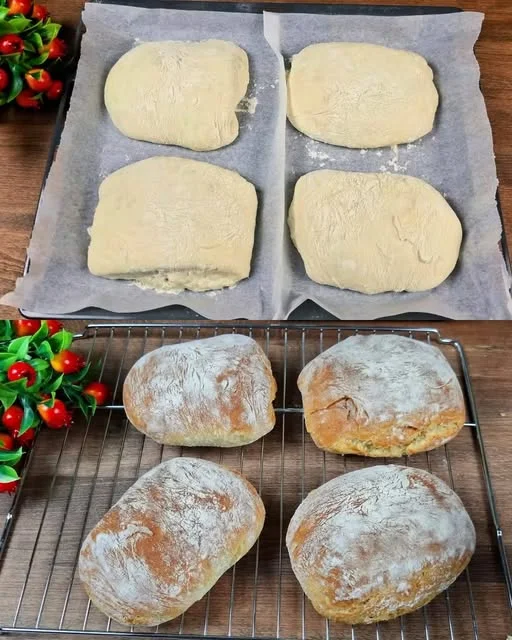There’s a certain smell that lives in my memory — warm, yeasty, a little earthy, with the faintest hint of olive oil. It’s the smell of my grandmother’s kitchen when she was baking bread. No timers, no scales, just her intuition, a wooden spoon, and a quiet kind of joy that filled the whole house.
As a child, I’d sit at the counter and watch her hands move — stretching, folding, turning flour into life. I remember thinking that bread had to be some kind of magic. But as I grew up, I also learned the truth many of us know too well: traditional bread making takes time, patience, and often a whole day. And life doesn’t always give us that kind of time.
Years later, in a busy apartment on a rushed weekday evening, I craved that smell again. I didn’t have the luxury of hours or the energy for kneading. What I had was one hour, a spoon, and a little hope. That’s when I discovered the liquid dough method — a bread recipe so forgiving and quick, it felt like I was cheating. But when I pulled the golden loaf out of the oven, crackly on top and tender in the center, it didn’t feel like a shortcut. It felt like home.
Why This Bread Is Different — And Brilliant
Traditional bread recipes call for flour, water, yeast, and salt — simple enough — but the process? Not so simple. Kneading, folding, proofing (twice!), shaping, and waiting hours for results that may or may not turn out right.
This version flips all that on its head. Instead of a stiff, elastic dough that needs to be worked and shaped, this bread starts with what’s often called a “liquid dough” — soft, sticky, pourable, and unbelievably easy. You mix everything in one bowl, let it rise once, then pour it into a pan or onto a baking sheet. That’s it.
The texture that comes from this technique is somewhere between a rustic Italian loaf and a chewy ciabatta. The outside develops a crisp, golden crust while the interior remains soft and airy with beautiful holes — the kind bakers chase when they talk about “open crumb.”
Ingredients
| Component | Ingredient | Quantity |
|---|---|---|
| Starter | Warm water | 100 ml |
| Sugar | 8 g (1 teaspoon) | |
| Dry yeast | 8 g (1 teaspoon) | |
| Bread flour | 50 g (about 3 tablespoons) | |
| Main Dough | Bread flour | 500 g (4 cups) |
| Salt | 8 g (1.5 teaspoons) | |
| Warm water | 350 ml | |
| Olive oil | 30 ml (2 tablespoons) |
Directions
- Activate the Starter
In a large bowl, mix 100 ml warm water with sugar and yeast. Stir in 50 g of bread flour. Let sit for 10–15 minutes until foamy. - Prepare the Dough
Add 500 g bread flour, salt, 350 ml warm water, and olive oil to the starter. Mix well using a wooden spoon or spatula until a soft, sticky dough forms. No kneading needed. - Rise and Rest
Cover the bowl with a clean towel or plastic wrap. Let the dough rise in a warm spot for 45–60 minutes, or until it doubles in size. - Preheat and Shape
Preheat the oven to 220°C (430°F). Line a baking tray with parchment paper or oil a loaf pan. Pour the risen dough directly into the pan or onto the tray — no shaping required. - Bake to Perfection
Bake for 25–30 minutes, or until the crust is golden and the loaf sounds hollow when tapped. Optional: Brush with olive oil or sprinkle with herbs before baking. - Cool and Slice
Remove from oven and cool on a wire rack for 10 minutes before slicing and serving.
Nutritional Information (Per Slice – Approx. 12 Slices)
| Nutrient | Amount (Approx.) |
|---|---|
| Calories | ~180 kcal |
| Carbohydrates | ~32 g |
| Protein | ~5 g |
| Fat | ~3 g |
| Saturated Fat | ~0.5 g |
| Fiber | ~1.5 g |
| Sodium | ~240 mg |
The Secret Is in the Simplicity
This bread relies on the power of hydration and a one-time rise. The high water content makes the dough more fluid and sticky, which might sound like a problem but is actually the key to that airy, tender crumb. And since the dough is so loose, there’s no need to knead it — the gluten develops naturally during the resting period.
It’s an ideal solution for:
- Busy parents who want homemade bread without the hassle
- Beginner bakers nervous about kneading
- Anyone short on time but craving real, fresh bread
- People looking for something more rustic and artisan than store-bought loaves
You don’t need a stand mixer, fancy tools, or prior experience. Just a bowl, a spoon, and an hour.
Serving Suggestions: From Simple to Sophisticated
What makes this bread even more appealing is its versatility. Once baked and cooled slightly, it’s ready to become anything you want it to be.
1. The Classic Table Loaf
Slice it thick, drizzle with olive oil, sprinkle with sea salt, and serve alongside soup or salad.
2. Garlic Bread Upgrade
Slice the loaf in half, brush with garlic butter, and broil until golden. You’ll never look at frozen garlic bread the same way again.
3. Rustic Sandwich Base
Use it for grilled cheese, paninis, or stacked veggie sandwiches. Its sturdy texture holds up beautifully under heat and fillings.
4. Toasted and Topped
Cut into wedges, toast, and top with ricotta and honey, roasted tomatoes and basil, or smashed avocado and chili flakes.
5. Breakfast Booster
Pair with jam and butter, or fry in olive oil for a rustic take on French toast.
Creative Variations: One Dough, Endless Possibilities
Though the base recipe is as simple as it gets, you can personalize it in countless ways:
Add Herbs
Mix in chopped rosemary, thyme, or oregano to the dough for an aromatic twist.
Go Whole Grain
Swap out a portion of the bread flour for whole wheat or rye for added depth and nutrition.
Top It Off
Before baking, sprinkle with sesame seeds, sunflower seeds, flaky salt, or even shredded cheese for a flavorful crust.
Stuff It
Pour half the dough into your pan, add thin layers of sautéed onions, olives, or soft cheese, then top with the rest of the dough.
Frequently Asked Questions
Is liquid dough harder to handle than traditional dough?
Not at all. It’s actually easier — you don’t knead or shape it. Just stir and pour. It may look messy, but it bakes beautifully.
Can I use all-purpose flour instead of bread flour?
Yes. Bread flour gives a chewier texture, but all-purpose flour still works great. You may get a slightly softer crumb.
Do I need a stand mixer?
Nope! Just a mixing bowl and a sturdy spoon. That’s the beauty of it — no machines, no kneading, no dough hooks.
Can I make it ahead of time?
Yes. You can mix the dough and refrigerate it overnight after the rise. The flavor will develop more, and you can bake it the next day.
Can I bake this in a Dutch oven?
Absolutely. A Dutch oven traps steam and creates a beautifully crisp crust. Just preheat the Dutch oven and pour the risen dough inside.
Can I double the recipe?
Yes. Just make sure to use a larger bowl for mixing and a bigger pan or split into two loaves.
How do I store the bread?
Once cooled, store it wrapped in a clean kitchen towel or paper bag at room temperature for up to 2 days. For longer storage, slice and freeze.
Can I add sugar for a sweeter bread?
Yes. A tablespoon or two of sugar or honey can add a hint of sweetness — perfect for breakfast toast or sandwich bread.
Tips for Perfect Liquid Dough Bread
- Warm water matters: Use water that feels warm to the touch (not hot). Too hot, and you’ll kill the yeast. Too cold, and it won’t activate well.
- Let it rise in a warm spot: A slightly warm oven (turned off) or sunny windowsill helps the dough rise faster and better.
- Use parchment paper: If you’re baking on a tray, lining it with parchment makes transferring and clean-up much easier.
- Be patient with cooling: As tempting as it is, let the bread rest at least 10 minutes before slicing to let the crumb set.
Conclusion: The Bread That Brings Baking Back to the Everyday
Bread has always had a way of anchoring us — to tradition, to nourishment, to home. But for too long, many of us believed that baking real bread was out of reach. Too complicated. Too time-consuming. Too messy.
This recipe changes that.
With just one bowl, a few pantry staples, and a little time, you can create something truly special. Not just food, but an experience. The scent of yeast and flour turning into something alive. The sound of crust crackling as it cools. The satisfaction of slicing into a loaf you made from scratch — on a whim, in an hour, with no stress.
And maybe, like me, it will bring you back to your grandmother’s kitchen. Or help you create a memory of your own.
So go ahead. Mix, pour, bake, and break bread — the easy way. It might just become the recipe you never knew you needed.


